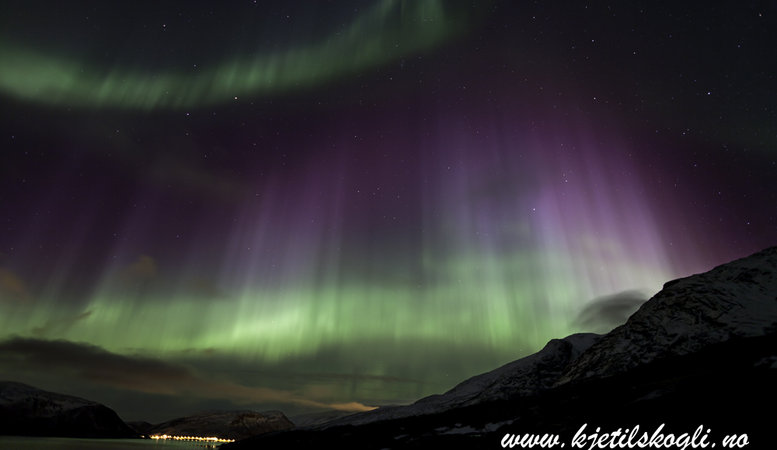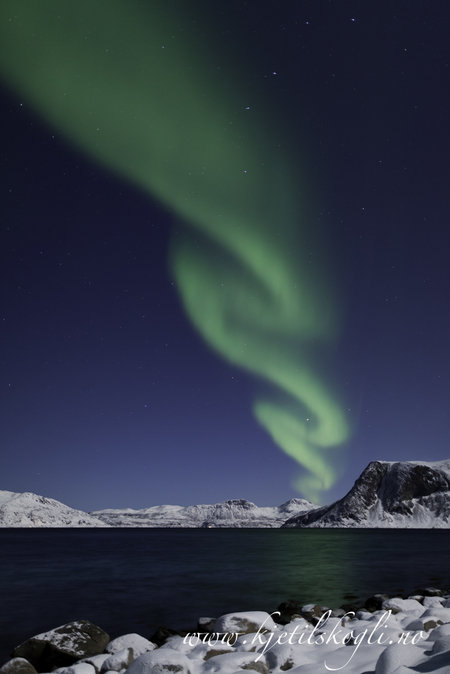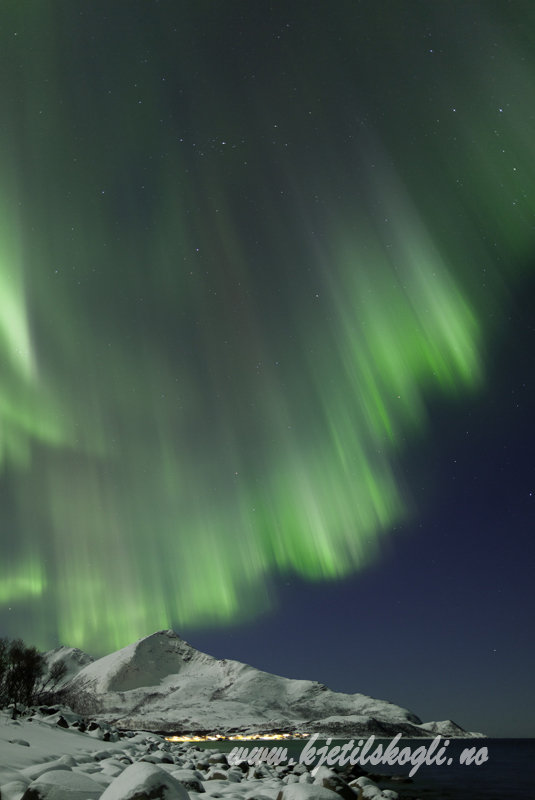Kjetil Skogli is one of the most experienced Northern Lights hunters in Northern Norway. Northern Lights holidays in Northern Norway really took off when he guided the British diva, Joanna Lumley, to a fantastic Northern Lights display which was seen by six million viewers when broadcast on British TV for the first time. Few in Northern Norway have more experience in finding Aurora than Kjetil.
Imagine sitting for seven or eight hours in a car in pitch-black darkness in a landscape with not a soul around, 350 kilometres (217 miles) north of the Arctic Circle, just to get a glimpse of the Northern Lights. And not even being guaranteed to see them? Hunting the lights through the winter nights has become a veritable epidemic in Northern Norway, but Kjetil Skogli in Tromsø was one of the very first to launch the idea of mobile Northern Lights hunting.
The BBC joined an aurora hunt
In 2008, Kjetil was the Northern Lights guide for the BBC when they were filming the quest for the elusive lights with the British actress and campaigner, Joanna Lumley. Early in March, Joanna Lumley was filmed at Spåkenes near Lyngenfjorden, when she was granted the opportunity to see a fantastic Northern Lights display in shimmering green, white, pink and deep violet. The reality far exceeded what the cameras were able to capture, and even veteran Kjetil was impressed.
Further information on aurora watching in Lyngenfjord
Kjetil Skogli has his own website offering tours in the winter time to see the lights.
Visit Tromsø are your go to source of information for Tromsø and the surrounding region, including advice on aurora locations.
Visit Lyngenfjord have a comprehensive website on the Lyngen area.

Joanna Lumley shined as bright as the aurora
“Joanna is a fantastic person”, says Kjetil; “she’s as big a star as Aurora. But she’s no snob; she even carried suitcases, and she was wonderful with the people we met along the way. Even after six or seven hours of snowmobile-driving and filming in Kautokeino, the smile and the make-up were in place. It says something that even someone like me actually noticed the make-up. So it’s not by chance that some people become big stars. Some people have just got it.”
The quest marked the turning point in aurora tourism
At the time, Kjetil had already been running Northern Lights tours for tourists for a couple of years. He had learned all the techniques for photographing the lights successfully, and had gained experience in finding clear skies and good chances of viewing the displays. When Joanna Lumley popped up on British TV screens, everything was set for success. “We who helped create the programme have every reason to be proud,” adds Kjetil, “for it has done a huge amount to promote Northern Norway as a winter destination.”
Clear skies are the most important factor
The idea is to be mobile and flexible, to drive wherever the weather conditions are best at any time. When the ice-cold east wind bites, the skies are often brilliantly clear out on the coast, while it can be cloudy inland. When the rain clouds hang over Tromsø, the dry areas behind the Lyngen Alps can be the best places. Kjetil has learned never to cancel a trip, for even under the worst conditions the cloud cover has thinned and Aurora has revealed herself with a dazzling display. It is important to let visitors have the chance to experience this, even if the conditions appear poor at first.
Kjetil will do whatever he can to find the lights
“We start at 6.30pm and keep going until there’s no more hope,” says Kjetil. On fine Northern Lights nights, he may deliver satisfied and bedazzled questers back to their hotels at nearly one in the morning, whereas on difficult nights it may be as late as 3am. On some nights they may drive as far as 100 kilometres (62 miles), on more challenging nights right up to 400 kilometres (249 miles), but Kjetil has no thought of time or distance; it is the chance of seeing the Northern Lights that counts.
Landscape is everything for photography
“It’s always important to find a good spot with an interesting foreground,” emphasises Kjetil. Fjords, islands, mountain formations; photographs of the Northern Lights are always better against the backdrop of the Northern Norway landscape. Kjetil has had plenty of training in finding good subjects to photograph, and assures us that he is always just as enthusiastic as the visitors when Aurora starts her evening performance.
Sometimes the lights spark proposals
What happens when the Northern Lights flame across the sky? According to Kjetil, people react very differently – from whooping and yelling to being completely stunned and dumbfounded. A sighting of the lights can easily make one feel weak at the knees; and some people have even gone down on their knees and proposed to their sweethearts – often after months of planning and secrecy. So far, all of them have said yes; for, as Kjetil says: “If she won’t say yes under the Northern Lights, it wasn’t meant to be.”
Disappointment is occasionally inevitable
There are, of course, failures, despite all the effort. As a rule this happens because the weather is too unpredictable, but sometimes it’s because the Northern Lights simply don’t appear. People show surprisingly little disappointment, however. “They’ve seen the huge amount of work I put into finding the Northern Nights, and thank me for my efforts. But I’m enjoying myself at work just as much as when we’re successful, to put it that way,” says Kjetil. Expectations have to be kept down at a reasonable level, but at the same time the enthusiasm for the quest has to be maintained.
The camera sees more than the eye can
Some people who see the Northern Lights can also be a bit disappointed because they don’t see all the colours they’ve expected to see. They may have seen some fabulous images of the lights online. The camera lens captures colours better than the human eye at night; the green colours are stronger and the pink stripe that is barely visible to the naked eye is more distinct. The colours often become sharper when the images are post-processed.
Aurora hunting is a way of life
“Regardless of whether the conditions are good or poor, I always make a proper trip out of it,” stresses Kjetil. “We often build a campfire and I take coffee, tea and cookies with me. If the weather’s good and the group members are fit, I take some snowshoes. While we wait, I talk about what makes the Northern Lights occur, about the myths surrounding the lights, and about life in Northern Norway. It only helps to shorten the waiting time, though. Finding clear skies and the Northern Lights is the first priority, and takes precedence over absolutely everything else.”



